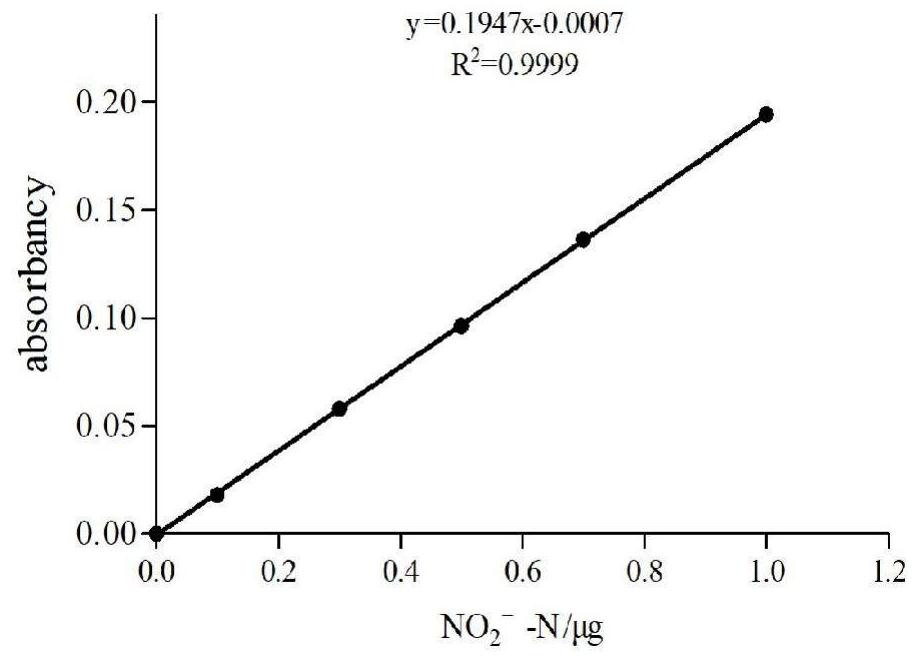An anomalous Wickhamian yeast strain capable of degrading nitrite
A nitrite and Wickham's technology, applied in the field of bioengineering, can solve the problem of few detailed reports of yeast, and achieve the effects of no pollution to the environment, stable degradation, and improvement of water quality
- Summary
- Abstract
- Description
- Claims
- Application Information
AI Technical Summary
Problems solved by technology
Method used
Image
Examples
Embodiment 1
[0031] Example 1 Isolation and identification of abnormal Wickham yeast WP-1
[0032] The original water sample was taken from Wanping Scenic Area, Rizhao City, Shandong Province; 12.5mL water sample was enriched in a 250mL sterile Erlenmeyer flask containing nitrite enrichment medium, 72h at 28°C; 12.5mL fresh enrichment medium was added every day Medium.
[0033] After 72 hours of incubation at 28°C, the inoculated strains were diluted 10 times, and 0.5 mL was evenly spread on the surface of the separation medium, and incubated at 28°C for 72-96 hours.
[0034] After the samples were naturally dried, the petri dish was placed upside down and placed in a constant temperature incubator at 30°C for cultivation. According to the morphological characteristics and dominance of the colonies, 8 representative strains were isolated. According to the color and morphological characteristics of the colony, select a representative single colony, and organize the purification medium pla...
Embodiment 2
[0059] Example 2 Safety detection test of abnormal Wickham yeast (WP-1)
[0060] Litopenaeus vannamei (Penaeus vannamei) is one of the important aquatic species, so this strain was selected for biosafety evaluation:
[0061] Healthy shrimp (3±1cm) were selected from a farm in Rizhao City, cultured in artificial seawater prepared with 8‰ sea salt 7 days in advance, and tap water that had been aerated was selected as experimental water. ClO 2 After disinfection, the shrimps were randomly divided into 3 experiments and 3 control groups, each in a 5L artificial seawater pool (Yantai Yi Plastic Packaging Products Co., Ltd.), with 30 shrimps in each group. Centrifuge 100mL bacterial liquid (1.5×10 8 cfu / mL (the optimal inoculum amount obtained through optimization experiments), resuspend 10 mL of sterilized seawater, and wash 2-3 times with the same volume of sterilized seawater. In the experimental group, 1 mL of suspended bacterial cells was added to each water tank, and in the...
Embodiment 3
[0064] The influence of embodiment 3 temperature, pH, carbon source type and C / N on the growth rate of WP-1 bacterial strain
[0065] In a 250mL Erlenmeyer flask, add 1.4×10 8 cfu of WP-1-1 5% (v / v) strain solution and 95% (v / v) basal medium: 0.05g NaNO 2 , 0.5g glucose, 0.05g KH 2 PO 4 , 0.01g MgSO 4 ·7H 2 O, 0.5mL FeSO 4 ·EDTANa 2 (*1000) and sterile water to make a total volume of 100mL.
[0066] Cultivate in a shaker at 180r / min for 48h, repeat 3 times.
[0067] The pH is set to 4, 5, 6, 7, 8, 9; the temperature is set to 15, 20, 25, 30, 35, 40°C;
[0068] The type of carbon source is sucrose, maltose, glucose, glycerol and no carbon source as a control (the addition amount of different carbon sources is 0.5g);
[0069] C / N (glucose / sodium nitrite) is 10:1, 15:1, 20:1, 25:1, 30:1 and 35:1; (the above ratio adjustment is achieved by changing the amount of substances added to the medium)
[0070] Under the settings of different pH, temperature, carbon source and C / ...
PUM
 Login to View More
Login to View More Abstract
Description
Claims
Application Information
 Login to View More
Login to View More - R&D
- Intellectual Property
- Life Sciences
- Materials
- Tech Scout
- Unparalleled Data Quality
- Higher Quality Content
- 60% Fewer Hallucinations
Browse by: Latest US Patents, China's latest patents, Technical Efficacy Thesaurus, Application Domain, Technology Topic, Popular Technical Reports.
© 2025 PatSnap. All rights reserved.Legal|Privacy policy|Modern Slavery Act Transparency Statement|Sitemap|About US| Contact US: help@patsnap.com



